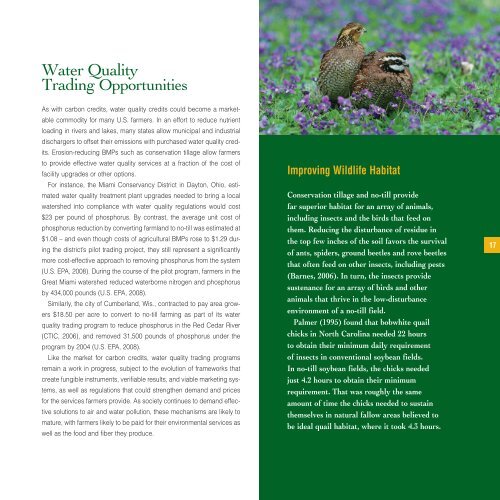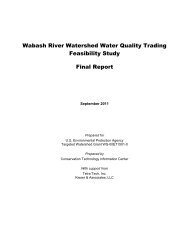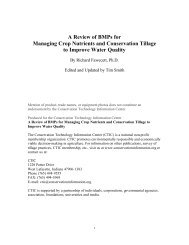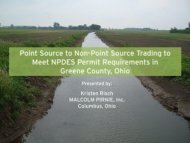Facilitating Conservation Farming Practices and Enhancing ...
Facilitating Conservation Farming Practices and Enhancing ...
Facilitating Conservation Farming Practices and Enhancing ...
You also want an ePaper? Increase the reach of your titles
YUMPU automatically turns print PDFs into web optimized ePapers that Google loves.
Water Quality<br />
Trading Opportunities<br />
As with carbon credits, water quality credits could become a marketable<br />
commodity for many U.S. farmers. In an effort to reduce nutrient<br />
loading in rivers <strong>and</strong> lakes, many states allow municipal <strong>and</strong> industrial<br />
dischargers to offset their emissions with purchased water quality credits.<br />
Erosion-reducing BMPs such as conservation tillage allow farmers<br />
to provide effective water quality services at a fraction of the cost of<br />
facility upgrades or other options.<br />
For instance, the Miami Conservancy District in Dayton, Ohio, estimated<br />
water quality treatment plant upgrades needed to bring a local<br />
watershed into compliance with water quality regulations would cost<br />
$23 per pound of phosphorus. By contrast, the average unit cost of<br />
phosphorus reduction by converting farml<strong>and</strong> to no-till was estimated at<br />
$1.08 – <strong>and</strong> even though costs of agricultural BMPs rose to $1.29 during<br />
the district’s pilot trading project, they still represent a significantly<br />
more cost-effective approach to removing phosphorus from the system<br />
(U.S. EPA, 2008). During the course of the pilot program, farmers in the<br />
Great Miami watershed reduced waterborne nitrogen <strong>and</strong> phosphorus<br />
by 434,000 pounds (U.S. EPA, 2008).<br />
Similarly, the city of Cumberl<strong>and</strong>, Wis., contracted to pay area growers<br />
$18.50 per acre to convert to no-till farming as part of its water<br />
quality trading program to reduce phosphorus in the Red Cedar River<br />
(CTIC, 2006), <strong>and</strong> removed 31,500 pounds of phosphorus under the<br />
program by 2004 (U.S. EPA, 2008).<br />
Like the market for carbon credits, water quality trading programs<br />
remain a work in progress, subject to the evolution of frameworks that<br />
create fungible instruments, verifiable results, <strong>and</strong> viable marketing systems,<br />
as well as regulations that could strengthen dem<strong>and</strong> <strong>and</strong> prices<br />
for the services farmers provide. As society continues to dem<strong>and</strong> effective<br />
solutions to air <strong>and</strong> water pollution, these mechanisms are likely to<br />
mature, with farmers likely to be paid for their environmental services as<br />
well as the food <strong>and</strong> fiber they produce.<br />
Improving Wildlife Habitat<br />
<strong>Conservation</strong> tillage <strong>and</strong> no-till provide<br />
far superior habitat for an array of animals,<br />
including insects <strong>and</strong> the birds that feed on<br />
them. Reducing the disturbance of residue in<br />
the top few inches of the soil favors the survival<br />
of ants, spiders, ground beetles <strong>and</strong> rove beetles<br />
that often feed on other insects, including pests<br />
(Barnes, 2006). In turn, the insects provide<br />
sustenance for an array of birds <strong>and</strong> other<br />
animals that thrive in the low-disturbance<br />
environment of a no-till field.<br />
Palmer (1995) found that bobwhite quail<br />
chicks in North Carolina needed 22 hours<br />
to obtain their minimum daily requirement<br />
of insects in conventional soybean fields.<br />
In no-till soybean fields, the chicks needed<br />
just 4.2 hours to obtain their minimum<br />
requirement. That was roughly the same<br />
amount of time the chicks needed to sustain<br />
themselves in natural fallow areas believed to<br />
be ideal quail habitat, where it took 4.3 hours.<br />
17








